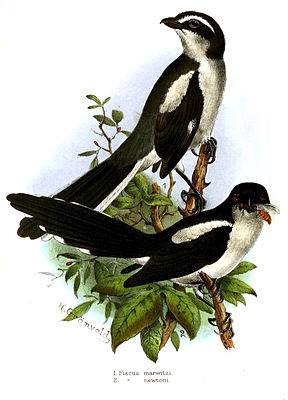Newton strangler
| Newton strangler | ||||||||||||
|---|---|---|---|---|---|---|---|---|---|---|---|---|

Newton shrike ( Lanius newtoni ), lower figure, |
||||||||||||
| Systematics | ||||||||||||
|
||||||||||||
| Scientific name | ||||||||||||
| Lanius newtoni | ||||||||||||
| Barboza du Bocage , 1891 |
The Newton's shrike ( Lanius newtoni ), sometimes referred to as the São Tomé shrike , is a very rare species of bird in the shrike family . It is endemic to the island of São Tomé in the Gulf of Guinea . The species is named after Francisco Newton , a Portuguese naturalist who worked for José Vicente Barbosa du Bocage .
description
The Newton shrike reaches a length of 20 to 21 centimeters. The bill, head, upper side and upper tail-coverts are black. The shoulders are characterized by a white and yellow tinted lightning pattern. The chin, chest, abdomen, flanks, rump, and under tail-coverts are light yellow. The tail is graduated. The middle tail feathers are black. The outer plumes are white, which increases from the inner to the outer tail feathers. The singing consists of an often repeated clearly whistled tiuh tiuh and a metallic tsink tsink , which can be heard over long distances.
habitat
The Newton shrike lives in primary lowland forests and forests at medium altitudes up to approx. 1,000 m. It is mainly found under the closed tree cover and on sides with little or no undergrowth. Many observations come from hills and streams.
status
Before its rediscovery in 1990, the Newton strangler was only known from two records from 1888 by Newton and 1928 by José G. Correia, who collected thirteen specimens. In July 1990 a single specimen was observed along the course of the Xufexufe in the southwest of the island of São Tomé. Since 1994 there have been regular observations in the Xufexufe basin. Furthermore, the species was observed near Valverde in the valley of the Rio Ió Grande in the middle of the island and south of Pequeno in the region of Bombaím . In 2007 there was evidence from Ribeira Peixe and Ana Chaves. Based on the few observations, BirdLife International estimates the population to be less than 50 specimens. The actual population is unknown, however. In the past, the greatest threat has been the transformation of forests into cocoa and coffee plantations . Invasive animal species such as house rats or the monkey cat as well as the palm grapevine harvest represent a potential threat. In the future, the increasing number of small farms and the associated clearing of trees could further restrict the habitat of the Newton's shrike.
literature
- Erik Hirschfeld (2007): The Rare Birds Yearbook 2008 , MagDig Media Ltd., Shrewsbury ISBN 978-0-9552607-3-5
Web links
- Le Guide des oiseaux de São Tomé et Príncipe ( Memento of October 7, 2008 in the Internet Archive ) (description in French)
- Birdlife species factsheet
- Lanius newtoni inthe IUCN 2013 Red List of Threatened Species . Listed by: BirdLife International, 2012. Retrieved February 5, 2014.